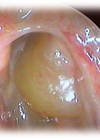The vexed topic of reflux always generates much discussion, particularly when it comes to testing. We hear about a non-invasive assay that is gaining in popularity. Voice disorders impact around four percent of the UK population and can significantly hamper an individual’s quality of life and their ability to work, costing the British economy an estimated £200 million every year [1].
These conditions can result from inflammation of the larynx, which may lead to hoarseness, vocal fatigue and discomfort when speaking. Inflammation can be caused by a variety of factors including infections, alcohol abuse, allergens, and often-misdiagnosed laryngopharyngeal reflux (LPR). In LPR, aerosolised stomach contents travel proximally beyond the oesophagus into the larynx and pharynx. Digestive enzymes that are normally only present within the stomach – such as pepsin – can affect the mucosa of the upper aerodigestive tract, causing inflammation. LPR is estimated to be responsible for up to 10% of otolaryngology consultations but, unlike other reflux diseases, LPR sufferers do not typically experience heartburn. For this reason, the condition is also termed ‘silent reflux’, and is unfortunately frequently missed [2].
Challenges in LPR diagnostics and effective treatment
Identifying LPR as the cause of a voice disorder is crucial for timely, targeted and effective therapy. However, the symptoms commonly associated with the condition are non-specific; for example, hoarseness, excess throat mucus, difficulty swallowing and breathing difficulties, often accompanied by a persistent dry cough and a globus sensation [3]. This lack of a specific symptom profile makes it difficult to confidently rule out or identify LPR in primary care, sometimes resulting in misdiagnosis and potential delays to the correct course of treatment.
"Salivary pepsin is now well established as a reliable biomarker for airway reflux and LPR"
While general practitioners are becoming increasingly aware of the presentation of LPR, there is still a tendency to prescribe proton pump inhibitors (PPIs) and antacids to patients with any non-specific reflux symptoms, irrespective of whether or not the voice is also affected. However, there is currently no strong evidence demonstrating the effectiveness of PPIs when prescribed as standalone treatments for LPR, and they are deemed most effective when combined with liquid alginate preparations and lifestyle modifications [4]. Concern is also mounting about the long-term use of PPIs, as they have been associated with numerous side effects, including increased susceptibility to enteric infections, liver diseases and pneumonia, and can also impair the absorption of certain nutrients [4]. Gastric acid is required for the release and absorption of several vitamins and minerals from food sources, and studies suggest that reducing the acidity of the gastric contents may lead to deficiencies in calcium – reducing bone density – as well as vitamin B12, magnesium and iron [4]. These risks and side effects highlight the need for more advanced methods of diagnosing LPR in primary care settings in order to prevent inappropriate treatment.


Similarly, in secondary care, the diagnostic pathway is not always as efficient as it could be. Patients are referred to a specialist speech and language therapist (SLT), and an initial appointment typically includes an in-depth voice assessment, collecting a comprehensive patient history and diagnostic investigations including nasendoscopy [5]. These investigations help to establish the aetiology of the voice disorder and direct the therapeutic interventions that follow [6], but are invasive, time consuming and costly for the hospital.
Enhancing healthcare with fast and accurate pepsin assays
Salivary pepsin is now well established as a reliable biomarker for airway reflux and LPR [2]. Peptest® from BIOHIT HealthCare is a non-invasive diagnostic tool for the detection of the biomarker pepsin, and provides a fast, reliable and accurate measure of the severity of LPR. It uses a double monoclonal antibody capture technique incorporated into an easy-to-use lateral flow device to determine the presence of pepsin in upper digestive and respiratory samples taken in primary and secondary care, or in the patient’s home. For example, the SLT team at Doncaster Royal Infirmary, one of the four hospitals that make up the Doncaster and Bassetlaw Hospitals NHS Trust, uses Peptest in routine clinical practice to help identify whether LPR is the underlying cause of our patient’s vocal problems. We deliver the Peptest kit to our patients along with detailed, step-by-step instructions in how to collect saliva samples themselves at home. They then send their samples in the secure packaging provided with the kit to the dedicated laboratory for analysis. We receive test results directly from the lab, usually within 24 hours of receipt, which enables us to make a fast diagnosis, and plan personalised treatment and follow-up. Peptest’s rapid turnaround time and high accuracy also make it the ideal solution for confidently diagnosing or ruling out LPR in primary care, without uncomfortable and time-consuming invasive procedures. Its specific, quantitative results can then be used to more efficiently direct referrals to SLT services for timely treatment, supporting the team in restoring and preserving patients’ vocal health.
A promising outlook for LPR patients
Historically, vocal disorders involving inflammation of the larynx have presented a considerable challenge to clinicians working in SLT, as the general lack of non-invasive and precise diagnostic methods has led to a reliance on reported symptoms, clinical observations and endoscopy. This approach to diagnosis may have increased the risk of potential misdiagnoses and unnecessary PPI use at a primary-care level, and additional time and cost investment for the NHS in secondary care. These issues demonstrate a clear need for more accurate and efficient ways of diagnosing silent reflux, and we are now using Peptest at Doncaster and Bassetlaw Hospitals NHS Trust to fill this long-standing diagnostic gap. The assay has additionally already played a pivotal role in numerous studies and clinical trials [2], establishing its efficacy as a valuable diagnostic tool and its potential for improving the quality of care for those experiencing voice disorders caused by LPR.
References
1. NHS University College London Hospitals. The Royal National ENT Voice Centre.
www.uclh.nhs.uk/our-services/
find-service/ear-nose-and
-throat-services-1/voice-clinic
2. Dettmar PW, Watson M, McGlashan J, et al. A Multicentre Study in UK Voice Clinics Evaluating the Non-invasive Reflux Diagnostic Peptest in LPR Patients. SN Compr Clin Med 2020;2(1):57–65.
3. Royal Berkshire NHS Foundation Trust. Silent reflux (also called LPR or EOR).
www.royalberkshire.nhs.uk/media/
gjrlmkdc/silent-reflux_aug21.pdf
4. Campagnolo A, Priston J, Thoen R, et al. Laryngopharyngeal Reflux: Diagnosis, Treatment, and Latest Research. Int Arch Otorhinolaryngol 2013;18(02):184–91.
5. The Royal College of Speech & Language Therapists. Voice – overview.
www.rcslt.org/speech-and-language-therapy/
clinical-information/voice/#section-1
6. Royal College of Speech and Language Therapists. RCSLT position paper: Speech and language therapy endoscopic evaluation of the larynx (EEL) for clinical voice disorders.
www.rcslt.org/wp-content/uploads/
media/docs/clinical-guidance/RCSLT
_Endoscopy-position-paper.pdf
All links last accessed March 2024.
Declaration of competing interests: None declared.









